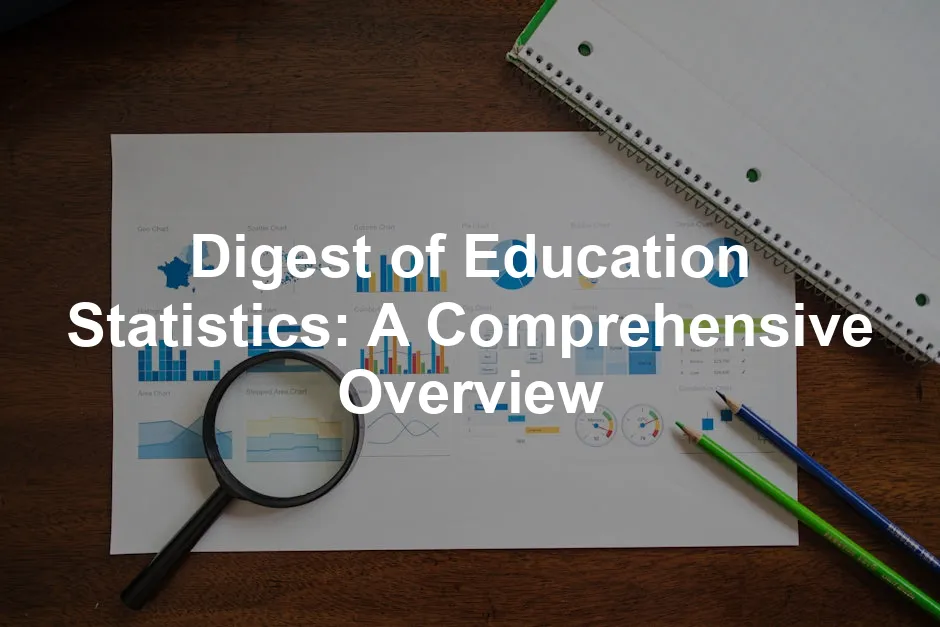Introduction
The Digest of Education Statistics stands as a vital resource for understanding the intricate landscape of education in the United States. Spanning from prekindergarten to graduate levels, it offers a treasure trove of statistical information. This resource, published annually by the National Center for Education Statistics (NCES), provides insights that are indispensable for educators, policymakers, and researchers alike.
Launched as part of the NCES mission, the Digest has been compiling educational data since 1962. Its primary aim is to present a comprehensive collection of relevant statistics that can guide educational planning and reform. Each edition serves as a snapshot of the educational system, showcasing key metrics that reflect trends and shifts in American education.
Why are education statistics so crucial? Well, these figures shape policies that affect funding, curriculum development, and educational standards. Decision-makers rely heavily on this data to ensure effective allocation of resources. Without robust statistics, how can we identify areas needing improvement or measure the success of educational initiatives? The Digest plays a critical role in bridging this gap.
The types of data included in the Digest are vast. It covers the number of institutions, student enrollments, teacher demographics, educational attainment, and financial statistics. Moreover, it dives into international comparisons and population trends. This comprehensive approach ensures that stakeholders have the necessary tools to make informed decisions that enhance the educational landscape.
In a world where data drives decisions, the Digest of Education Statistics stands out as a beacon of clarity and insight. It empowers us to understand the current state of education and envision the future. So, buckle up and let’s navigate through the wealth of information provided in this essential resource! And if you’re eager to dive deeper into educational insights, consider grabbing a copy of Digest of Education Statistics 2021 to keep all the facts at your fingertips!

What is the Digest of Education Statistics?
The Digest of Education Statistics is more than just a compilation of numbers; it’s a narrative of American education. Since its inception, the Digest has aimed to summarize statistical information covering education from prekindergarten through graduate school. With contributions from various surveys and research activities by the NCES, this annual publication encapsulates the educational journey in the U.S.
Founded in 1962, the Digest has evolved to meet the needs of its audience. Over time, it has expanded its scope to reflect changing educational dynamics and the growing demand for data-driven insights. The NCES, the principal entity behind the Digest, is dedicated to collecting and analyzing educational data to inform policymakers and educators.
What can you expect to find in the Digest? A wide range of topics awaits! It includes data on the number of schools and colleges across the nation, enrollments at different educational levels, and statistics on teachers. The publication also highlights educational attainment, providing a clear picture of how many individuals achieve various degrees. If you’re interested in understanding the methods behind the data, Research Methods in Education is an excellent resource!
Furthermore, financial statistics are prominently featured. These figures shed light on federal funding, educational expenditures, and available financial aid options. The Digest also doesn’t shy away from international comparisons, offering insights into how the U.S. stacks up against other countries regarding education. For more detailed insights, consider exploring the education statistics digest.

The Digest serves as a significant resource for educational data. For comprehensive insights, check out the education statistics digest.
In summary, the Digest of Education Statistics serves as a comprehensive resource that encapsulates various aspects of American education. From foundational statistics to financial insights, it provides a rich tapestry of data that informs our understanding of the educational landscape. Whether you are a policymaker, educator, or just a curious mind, this resource is indispensable for grasping the complexities of education in the U.S. Speaking of complexities, if you’re looking to improve your statistical knowledge, check out Statistics for Dummies for a fun and easy way to get started!

Key Components of the Digest
The Digest of Education Statistics is a treasure map of educational data. It offers rich insights into various aspects of American education. Let’s break down its main sections and uncover the statistics they provide.
Schools and Colleges
First up, we have the number and types of institutions. The Digest encapsulates data on public and private schools, as well as colleges and universities. In recent years, there have been over 130,000 public schools and approximately 4,000 degree-granting institutions. This includes community colleges, four-year universities, and specialized training schools. Each category serves distinct purposes, catering to different educational needs. For those looking to understand the foundational structures of these institutions, The Essentials of Statistics is a must-read!
This section helps to visualize the educational landscape. Are we seeing more charter schools? How about the growth of online institutions? The Digest keeps track!

Teachers and Enrollments
Next, we turn to the tireless educators and eager learners. The statistics here cover teacher demographics, including age, gender, and ethnicity. Did you know that a significant majority of teachers are female? In fact, women make up around 76% of the teaching workforce! This section also highlights student enrollment figures, which have been fluctuating.
In recent years, total enrollment in public elementary and secondary schools has hovered around 50 million. It’s a staggering number! The Digest provides a breakdown of enrollment by grade level and demographic details, allowing us to see shifts in diversity and educational access. If you want to deepen your understanding of educational engagement, consider reading The Teacher’s Guide to Student Engagement.

Graduates and Educational Attainment
What about the fruit of all that labor? Graduation rates and degrees awarded are front and center in this section. The Digest reveals that high school graduation rates have been steadily increasing, now exceeding 85%. This is great news for American education!
On the college front, over 3 million degrees are awarded annually. With the majority being bachelor’s degrees, the statistics reveal that more students are pursuing higher education than ever before. This section also helps us understand trends in educational attainment across different demographics, shedding light on gaps that still exist. For a deeper exploration of educational pathways, check out The College Admissions Mystery.

Finances
Let’s talk money! The finances section offers a deep dive into educational funding. It covers federal contributions, state funding, and local expenditures. In the 2020-2021 school year, total U.S. public elementary and secondary school spending reached nearly $800 billion. That’s a lot of dough!
Additionally, financial aid statistics are included. Approximately 70% of college students receive some form of financial aid. This section helps us grasp the financial landscape of education, revealing how funding can impact educational quality. For those curious about the financial intricacies, How to Measure Anything: Finding the Value of ‘Intangibles’ in Business is a great read.

Libraries and International Education
Libraries play a crucial role in education. This section includes statistics on school and public libraries, highlighting their resources and usage rates. Did you know that over 90% of public schools have a library?
International comparisons are also presented. How do we stack up against other countries? The Digest provides insights into how U.S. students perform on assessments compared to their international peers, revealing both strengths and areas for improvement. If you want to delve deeper into data analysis, consider Data Analysis with Open Source Tools.

Population Trends
Demographic shifts can shake up education statistics. This section examines how changing populations impact enrollment, funding, and educational outcomes. For instance, the rise in Hispanic and Asian student populations is evident, reflecting broader societal changes.
Understanding these trends is essential for anticipating future educational needs and ensuring equitable access for all students. If you’re interested in understanding how societal factors play into education, grab a copy of The New Jim Crow: Mass Incarceration in the Age of Colorblindness.

Labor Force Characteristics
Finally, education’s role in employment and income levels is explored. This section emphasizes the correlation between education and career opportunities. Individuals with higher educational attainment tend to earn more and experience lower unemployment rates.
Statistics indicate that bachelor’s degree holders earn 57% more than those with only a high school diploma. The Digest showcases how educational achievement influences economic stability, making it a pivotal resource for understanding the value of education in the labor market. If you’re keen on personal development, consider reading Mindset: The New Psychology of Success.

In sum, the Digest of Education Statistics serves as a comprehensive repository of critical data. Each section reveals essential insights that help shape policies, guide educational practices, and inform stakeholders about the state of education in the U.S. Each bit of data contributes to a clearer understanding of our educational landscape, helping us make informed decisions for the future.

Trends in Education Statistics
In recent years, education statistics have revealed some intriguing trends that reflect the evolving landscape of American education. These trends provide a snapshot of where we stand and where we may be headed.
First, let’s talk about enrollment demographics. The shifts in who is enrolling in schools are nothing short of fascinating. Historically, white students dominated classrooms, but that’s changing. The number of Hispanic and Asian students is growing, contributing to a more diverse educational environment. In fact, recent statistics show that Hispanic students represent a significant portion of the K-12 population, indicating a broader cultural shift. This diversity is vital; it enriches classroom discussions and prepares students for a globalized society. To enhance your understanding of data-driven business decisions, consider reading Data Science for Business.

Next up, graduation rates! Good news here—these rates have seen a welcome upward trend. High school graduation rates have climbed to over 85%. This means more students are walking across that stage, diploma in hand. And college? Over 3 million degrees are awarded each year, with bachelor’s degrees leading the pack. This data points to a generation that values education and is willing to pursue higher learning, a trend that can only bode well for the future workforce.
Now, let’s turn our attention to the bucks—educational funding and resource allocation. It’s no secret that finances play a crucial role in shaping education. Recent data reveals a surge in funding levels, with total U.S. public school spending approaching $800 billion. This increase is essential for addressing the needs of a growing student population and ensuring that resources are available where they’re needed most. Speaking of resources, if you’re interested in practical applications of statistical data, The Data Detective: Ten Lessons for Better Data Analysis is a great resource!

But here’s a plot twist: the way funds are allocated is increasingly influenced by technology. Speaking of technology, its impact on education is a game changer. The pandemic accelerated the integration of digital tools in classrooms. Online learning became the norm almost overnight, and schools had to adapt. Statistics indicate that around 74% of classrooms now utilize smartphones, while 65% of students rely on laptops for homework. This tech-savvy approach is shaping educational practices, making learning more flexible and accessible.

In summary, education statistics over recent years are showcasing significant changes. The increasing diversity in enrollment demographics, rising graduation rates, enhanced funding, and the incorporation of technology are all pivotal trends. These factors together influence how education is delivered and experienced, ultimately shaping the future of learning in America.

Challenges in Education Statistics
While education statistics provide valuable insights, they come with their own set of challenges. Understanding these hurdles is essential for interpreting the data accurately.
First and foremost is data accuracy and comprehensiveness. Collecting educational data is no walk in the park. Various sources contribute to the statistics, and discrepancies can arise. Inconsistent reporting practices can lead to incomplete or misleading information. For instance, if one state reports graduation rates differently than another, it creates confusion when trying to draw comparisons.
Then there’s the issue of varying state and federal reporting standards. Each state has its own guidelines for collecting and reporting educational data. This can result in significant variations in how statistics are presented. For policymakers, this inconsistency complicates decision-making processes. It becomes challenging to assess how well a state is performing relative to others. To further understand these complexities, consider reading The Art of Statistics: Learning from Data.
Lastly, the impact of COVID-19 cannot be overlooked. The pandemic disrupted the entire education system, leading to altered data collection methods. Many schools transitioned to online learning, making it difficult to gather accurate enrollment and attendance figures. This shift has left gaps in the data, complicating efforts to analyze trends effectively.
In summary, while education statistics offer a wealth of information, challenges in data accuracy, reporting standards, and the effects of COVID-19 must be acknowledged. Recognizing these issues is vital for anyone looking to navigate the complex world of education data.
Conclusion
The Digest of Education Statistics is more than just a collection of numbers. It plays a pivotal role in shaping the future of American education by providing essential insights and data that inform decision-making at all levels. Policymakers, educators, and researchers rely on this publication for accurate and comprehensive statistics that reflect the state of education from prekindergarten through graduate school.
One of the key takeaways from this article is the sheer breadth of data included in the Digest. From the number of schools and colleges to enrollment figures, teacher demographics, and educational attainment, the Digest serves as a one-stop shop for anyone seeking to understand educational trends. Moreover, it highlights critical finance-related information that is crucial for budgetary considerations. If you’re also looking to navigate the world of investment, The Education of a Value Investor might be just what you need!
Utilizing the Digest is not just advisable; it’s essential for informed decision-making and effective policy development. With ever-evolving educational needs, the statistics compiled in this resource can help identify trends and gaps. This understanding is vital for crafting initiatives that address the diverse needs of students across the nation.
Additionally, the Digest fosters accountability within the education system. By providing data on various educational outcomes, stakeholders can measure the effectiveness of interventions and programs. It empowers educators to adapt their strategies based on what the data suggests, ultimately leading to improved student achievement. To further enhance your statistical acumen, consider Everything You Need to Know About Statistics.
In conclusion, the Digest of Education Statistics is a cornerstone for anyone involved in education. Its comprehensive nature and focus on relevant data make it an indispensable tool for shaping the future of education in the United States. So, whether you’re a policymaker, educator, or simply someone interested in education, make sure to keep the Digest close at hand. It’s your roadmap to understanding the complex landscape of American education. And if you’re also looking for a little inspiration, The Power of Habit: Why We Do What We Do in Life and Business is a fantastic read!
FAQs
What types of data are included in the Digest?
The Digest includes a variety of statistical information covering American education. This encompasses the number of schools and colleges, teacher demographics, enrollments, graduation rates, educational attainment, and financial statistics related to educational funding. It also includes supplemental information on population trends and library statistics.
How often is the Digest updated?
The Digest of Education Statistics is updated annually. The latest version, as of March 2023, provides the most current data available. Archived versions dating back to 1990 are also accessible for those interested in historical trends.
Who can benefit from using the Digest?
The Digest is beneficial for a wide range of stakeholders. Policymakers use it to guide educational reforms, educators leverage it for instructional planning, researchers rely on it for data analysis, and parents or students can gain insights into educational opportunities and outcomes.
Where can I find specific statistics on my state’s education system?
You can find state-specific statistics within the Digest, particularly in the new Digest State Dashboard feature. This tool offers enhanced data visualization, making it easier to access and interpret information relevant to your state’s education system. For more details, visit the NCES website for direct access to the Digest and its features.
Please let us know what you think about our content by leaving a comment down below!
Thank you for reading till here 🙂
All images from Pexels




